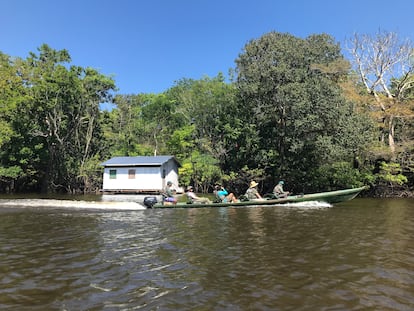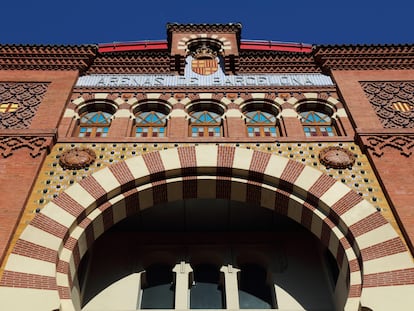From the hills of Barcelona to the beaches of Ibiza: why do sunsets fascinate us?
On Instagram there are more than 300 million images of sunsets. Between the hotels that offer rooftop sunset views and the lookouts that have to close because of crowds, it’s easy to see how business revolves around this natural phenomenon

Near the end of May, at seven in the evening on a Sunday, the terrace of the Kumharas cocktail bar – a classic spot in Sant Antoni, Ibiza, which has been open for 26 years – is quite a shock. Of the twenty tables, only two are occupied. Owner and founder Miguel Costa, 51, has strategically placed them to face the sea of this rocky beach.
We’ve been told that this is one of the most fashionable places on the island to watch the sunset. But clearly, we’ve been lied to. Somewhat dejected, we leave to take a walk through Sant Antoni, passing through the remains of the businesses set up around tourism from the UK. There are drunk revellers and signs that offer sausage breakfasts – the merchants seem to want to turn the area into a tribute to South Beach. This shift in marketing has been working: according to data from Spain’s National Statistics Institute, last year, 3.4 million tourists arrived on the island of Ibiza… an 8.3% increase compared to 2019 (pre-pandemic). However, compared to that year, they also spent 91.8% more money.
We return to Kumharas about an hour after we found it practically empty. With about 70 minutes to go until sunset (which is at 9:04 PM, according to an iPhone app), the place is suddenly packed to the brim. “Amazing, isn’t it?” Costa laughs. There’s a DJ, while the waiters are taking orders at full speed.
“You have to have a lot of staff and impeccable logistics for this to work. It’s about two hours before sunset during which we have this to burst,” the owner notes. “I tried to open in the morning, with yoga classes, workshops for children… but it didn’t make me much money. People want this (the sunset). I try not to be too expensive: I offer the mojitos at 10 euros, which is reasonable for the island. I’m interested in the public being like this, as you see it, varied: hard workers, islanders, foreigners, families. They’ve offered me the opportunity to host club-style pre-parties, but I’ve never wanted to. It’s the sunset that everyone likes,” he concludes, pointing to the sun, which is setting over the Mediterranean. With the music lowered, there’s almost silence. There’s even a bit of applause, like when a flight lands. Sunset number 149 of 2023 has concluded. Time to turn up the music again.
“Actually, I didn’t turn the music down,” says DJ Grayswan, a 50-year-old Englishman whose real name is Grayson Shipley. He speaks with EL PAÍS a couple of days after the night in question. Apparently, he was also doing dishes when we visited Kumharas.
“When I play at sunset, I take into account the time and also the place. In the case of Kumharas, the session was a bit more diverse and festive than in other places, because the clientele is like that,” he points out.
Sunsets have their own soundtrack. At Café del Mar, this reality has been taken into account – the sounds played in this establishment almost always revolve around deep house music. While you can dance to it, it’s almost introspective, capable of satisfying both the end of the day and the start of the night.
“Do you know what happened?” Shipley interrupts, to explain why we felt he had lowered the volume to keep up with the sunset. “I played a vocal track – its frequencies are higher and it makes the sound limiters go off. The island is full of them.” What a disappointment.
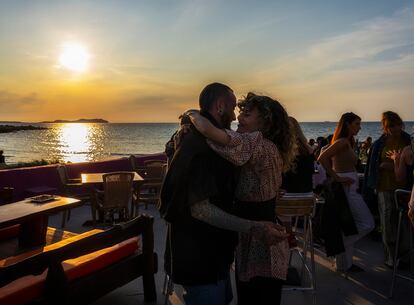
The pineal gland is located in the central portion of the brain. Its function is to regulate the heart rate in the sleep-wake cycle. This gland sleeps during the day, but at sunset, when sunlight decreases, it becomes active and begins to produce melatonin – the hormone that lowers cortisol levels, the stress hormone. Thus, sunset is the moment in which the body experiences the change from daytime functions to nighttime ones: this is when the soul calms down.
“It’s the transition from stress and activity to relaxation and rest,” explains Violeta Alcocer, a clinical psychologist based in Madrid. “The sunset is the perfect setting to accompany these neurochemical changes with a series of additional sensory stimuli that increase the feeling of relaxation and well-being. A natural spectacle that perfectly matches the impact of the sunset on our brain, enhancing its effect.”
Beyond the physiological, sunsets have metaphorical value. They are part of scientific reality, but they also provide humanistic value. “[A sunset represents] change… an end that, at the same time, is a beginning. Daytime concerns and obligations are left behind; night gives us permission to retire, if we wish, or surrender to enjoyment,” Alcocer says. She also sees sunsets as reminders of how the cosmos functions and of our place within it. Day in and day out, sunsets warn us that we are very insignificant. “It gives us perspective…[sunsets] reveal the incessant evolution of life,” the psychologist explains.
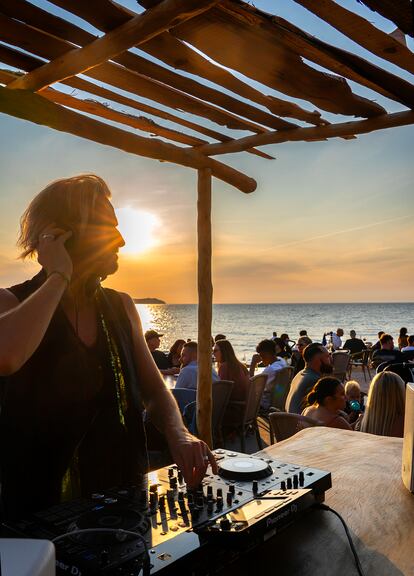
In Ibiza’s Cala Comte, a physical distance of just 300 feet – as well as an almost incomprehensible metaphysical interval – separates Sunset Ashram from the Hidden Cove beach bar. The first is a perfectly choreographed venue, with a restaurant, shop and lounge chairs facing the magnificent sunset. The beach bar, meanwhile, is next to what was once a nudist beach, which can be accessed by going down some stairs. It has about a dozen wooden tables and stools.
“We’re not in competition,” emphasizes Tess Harmsen, 35, who inaugurated the Hidden Cove back in 2015. It has already become a mythical space that attracts clientele that don’t necessarily have to be rich. “[Sunset Ashram] is a shark,” Harmsen explains. “They’ve been around for many years and they have their crowd. [Their patrons] come in buses. But we don’t even take reservations; I didn’t raise the price of beer (4.50 euros, barely five bucks) until recently, because [the suppliers] increased the cost for me. We have a place at the bar to order food and drinks to go… people can have it on the beach or the rocks, because the tables fill up very quickly.” The sunset that’s observed from each establishment is the same. However, the patron’s experience is remarkably different.
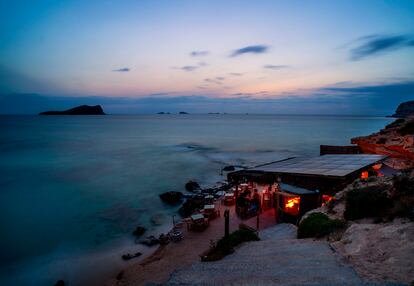
In a different part of Spain – in the Barcelona neighborhood of Carmel – during the month of April, the experience of locals is even more different. For them, sunsets don’t exactly bring peace and serenity. At the top of Turó de la Rovira (the Bunkers of Carmel) – 860 feet high, just short of the minimum height to qualify as a mountain – there are decommissioned anti-aircraft batteries that date back to the Spanish Civil War (1936-1939). This site offers spectacular 360-degree views of the city of Barcelona and its metropolitan area. From here, you can see the Sagrada Familia – the largest unfinished Catholic church in the world – and the architecturally-stunning Ciutat Meridiana borough. Climbing up to this lookout point to see the sunset has become a tourist destination.
However, this past April 7, the local police evicted 1,300 people from the lookout point, which had collapsed. Shortly afterwards, it was decided that this access would be closed at 7:30pm. You can still go look at the city during the day… but you can’t see the sunset because of the limited hours. In the middle of a Tuesday afternoon at the end of May, about 30 young people have gathered. Perched on the anti-aircraft batteries, they drink beer, sip mate and listen to music from their phones. There’s no longer a nighttime crowd of diners and tourists in the area.
“We haven’t seen a [dime] despite all the visitors,” laments a merchant from the door of the Delicias bar, located on Mühlberg street – one of the last shops you pass en route to the lookout point. “[The youngsters] only carry bags from those supermarkets,” he sighs, pointing to one of the bodegas that wouldn’t survive if not for all the packs of beer they sell.
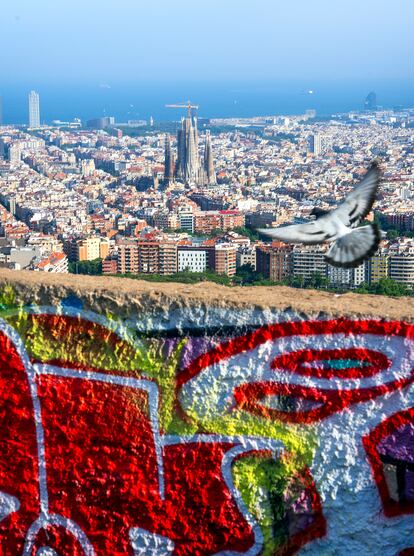
At the other end of the city, on the Montjuïc mountain, there are some municipal swimming pools, which hosted the diving competition during the 1992 Olympic Games. The architect – Antoni de Moragas – had the brilliant idea of demolishing one of the stands, which blocked the view. He subsequently created a lookout point that led to some of the most iconic images of those Games, as well as settings for international music videos. Nowadays, the task to make this place fashionable falls on Mar Ros, 61, a Barcelonan who runs the concession stand for the venue’s bar, which he has named Salts. “The sunset from here is perfect,” he says, pointing to the antenna atop the Sant Pere Màrtir mountain, on which the blazing sun will set in a while. People come, order their beers and sit in the stands to watch the sunset. Revenue increases by 35% during these hours.
There are tourists, but, above all, there are many people from the city, who finish work, go up Montjuïc – which is becoming more and more popular and increasingly integrated into Barcelona’s daily life – have a drink “and then go home for dinner,” says a girl who is visiting the mountain. She has come alone – she orders a beer and sits in the stands to read a book. This space is committed to everyday life, to integrating the sunset into the leisure routines of a city that, on more than one occasion, has been accused of only creating leisure routines for tourists. According to the National Statistics Institute, there were 9.7 million visitors to Barecelona in 2022, along with 29.8 million overnight stays.
“I understand that Instagram is important – and my partner is more interested than me – but what Instagram does is create mass… it doesn’t discriminate. Places fill up and they lose personality. [But] this sunset has character,” she says, pointing to the sunbeams that bounce off the water of the two swimming pools.

In 2010, the remote rock formation of Trolltunga, in Norway, welcomed 800 visitors who arrived after a four-hour-long hike. But in 2016 – after the images of its sunset became popular on Instagram – more than 80,000 people visited Trolltunga. On Instagram, the hashtag #sunset has more than 300 million entries. Images of sunsets all over the world confirm that there’s clearly an urge to photograph them every time we come across a new one.
“On social media, people want to share sensational moments,” says psychologist Violeta Alcocer. “A sunset is evocative for everyone – it’s an image that means many things, without the need to add anything more. That makes it something very appealing for social media users.”
According to a question posed to 79,000 people by the travel website MissTravel in 2021, 48% of surveyed Instagram users pick their vacation destination based on what they see online. One in three confesses that their use of Instagram is basically to discover new places. By age group, it’s millennials who trust this app to decide where they will have their next experience: 78% are devoted to Instagram, while barely 6% of members of generation X surveyed can say the same.
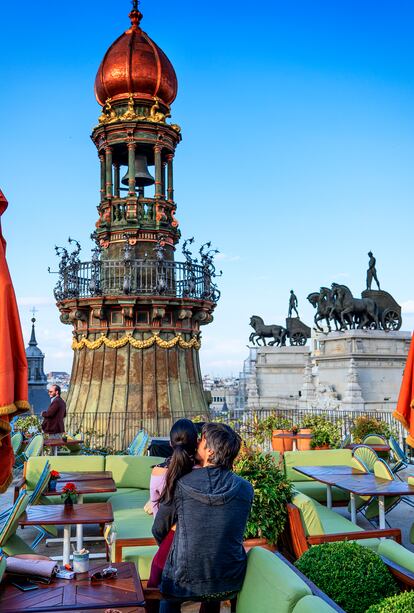
The day isn’t going well at Madrid’s Temple of Debod, which is one of the most popular spots in the capital to watch the sunset. In its gardens, some people are doing yoga, while others are sipping from beer cans. At the lookout point, barely a dozen visitors are taking photos – there are huge gray clouds in the background. The crowd is nowhere near the size of what you see on a clear summer day, or on those rare snowy days in winter. A group of vendors sit near a flower bed; there’s a lack of business today.
“Today, I’ve sold only three,” says one of the men, nodding to the cooler of beer cans and water bottles that he usually hawks while walking through the park. “On a normal day, [I make about] 20 euros.”
That’s around the price of a cocktail at Dani Brasserie, on the terrace of the Four Seasons hotel, opened in 2020 in Canalejas, Madrid. It’s one of the newer arrivals to the city that offers a rooftop, which has become a trendy way of competing for clientele, based on offering unique views and exclusive experiences. This afternoon at the Four Seasons, the sky looks a little clearer. The sunset – with the imperial buildings of the capital in the foreground – is a luxury.
“The key is the cirrus clouds,” warns meteorologist Benito Fuentes. It’s taken a full article to probe our fascination with sunsets… but in the end, it turns out that they’re the result of thin clouds that are made up of tiny ice crystals.
“As the sun approaches the horizon, its rays cover more space in the atmosphere. This causes the blue and violet colors to disperse, leaving us with the reddest colors. When the sun is up, those bluish tones prevail… that’s why we see the blue sky. So, at sunset, the reflection of those rays on the cirrus clouds is what makes it spectacular.”
Fuentes says that the esthetic quality of the sunset according to each season depends on the frequency of anticyclones. Hence, it’s likely that, in autumn and spring, we’re most likely to find the most beautiful sunsets. As for beauty by location, he insists on the democracy of sunset: every sunset is beautiful… we’re the ones who discriminate against them.
“Look, I live in Teruel (a small city in eastern Spain). One day, my mother told me that the sunset looks much more beautiful [in our city]. I had never noticed that before. The reason may be that the clay color of the soil in Teruel causes a more beautiful contrast.”
The meteorologist assures EL PAÍS that climate change has not yet affected the way in which sunsets appear to us every afternoon. Although, he does guess that, if hazy episodes become more common and the presence of chemicals in the sky increases, it’s possible that what we see may vary.
But will we feel differently? Fuentes pauses before answering. “I don’t think so… it’ll still be the best moment of the day.”
Sign up for our weekly newsletter to get more English-language news coverage from EL PAÍS USA Edition
Tu suscripción se está usando en otro dispositivo
¿Quieres añadir otro usuario a tu suscripción?
Si continúas leyendo en este dispositivo, no se podrá leer en el otro.
FlechaTu suscripción se está usando en otro dispositivo y solo puedes acceder a EL PAÍS desde un dispositivo a la vez.
Si quieres compartir tu cuenta, cambia tu suscripción a la modalidad Premium, así podrás añadir otro usuario. Cada uno accederá con su propia cuenta de email, lo que os permitirá personalizar vuestra experiencia en EL PAÍS.
¿Tienes una suscripción de empresa? Accede aquí para contratar más cuentas.
En el caso de no saber quién está usando tu cuenta, te recomendamos cambiar tu contraseña aquí.
Si decides continuar compartiendo tu cuenta, este mensaje se mostrará en tu dispositivo y en el de la otra persona que está usando tu cuenta de forma indefinida, afectando a tu experiencia de lectura. Puedes consultar aquí los términos y condiciones de la suscripción digital.
More information
Archived In
Últimas noticias
Welcome to the post-religion era: The idea of Christianity as the absolute truth has become obsolete
‘I thought you would like it’: The risky sexual practice popularized by TV shows and TikTok
The digitalization of tourism: ‘They promise experiences and gave us the worst possible one’
Mexican peso defies uncertainty with forecasts of a new period of stability in 2026
Most viewed
- Sinaloa Cartel war is taking its toll on Los Chapitos
- Oona Chaplin: ‘I told James Cameron that I was living in a treehouse and starting a permaculture project with a friend’
- Reinhard Genzel, Nobel laureate in physics: ‘One-minute videos will never give you the truth’
- Why the price of coffee has skyrocketed: from Brazilian plantations to specialty coffee houses
- Silver prices are going crazy: This is what’s fueling the rally

